
Old Airport Terminal Bldg. International flight, Tejgaon airport, Dhaka (Gr.Floor built in 1940s)

Old Airport Terminal Bldg. International flight, Tejgaon airport 1967, Dhaka

Terminal bldg. for Domestic flight, Tejgaon airport added in 1960s

Tejgaon hard strip in 1936

Tiger Moth

US war plane at Kurmitola airfield 1944

Orient Airways, Dhaka-Kolkata flight 1952

Douglas DC3 Dakota by PIA from 1955 to mid 60s

Lockheed L-1049 Super-Constellation, Dhaka-Karachi operated from 1954

Vicars Viscount 1958

Hawker Siddeley Trident introduced in 1966

Boeing 707 introduced in the 60s

Fokker F-27 Friendship in 1960s

Sikorsky S-61N helicopter service operated for remote areas of Bangladesh in Nov 1963 till 1967.

Twin Otters STOL introduced in 1970


Bangladesh Biman from 1972..
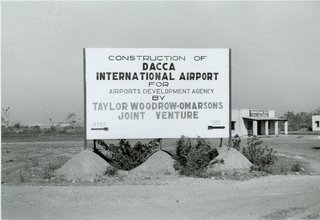
New airport construction site at Kurmitola during '60's

View of Airport rail station during late '60's
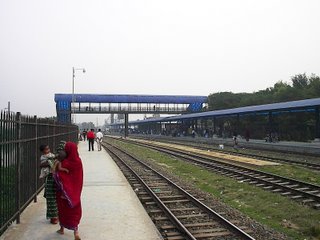
Airport Railway Station in 2000
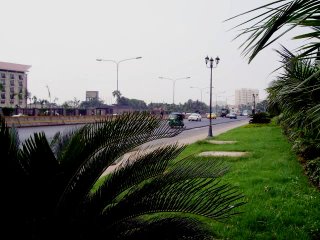
Dhaka - Airport road
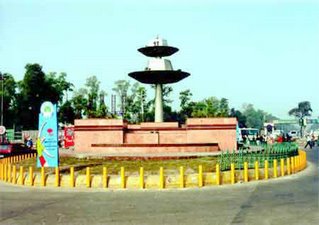
Fountain and roundabout in front of Airport

Terminal, north side- Zia International Airport
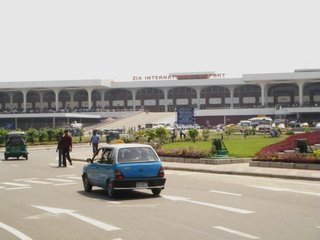
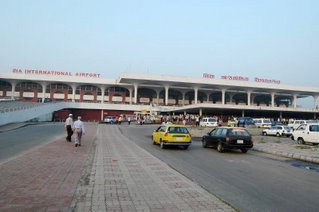
Terminal entry
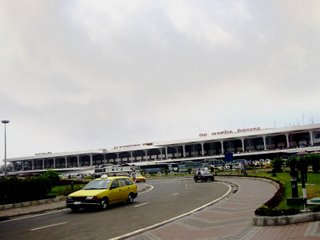
Zia International Airport- front view
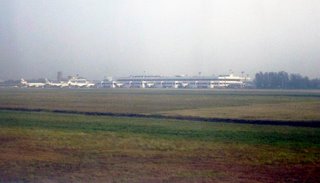
Zia International Airport - view from west
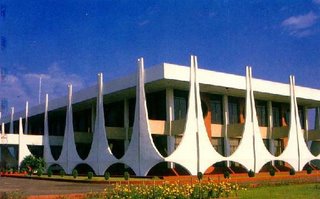
VIP lounge- south of terminal
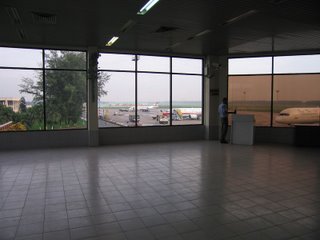
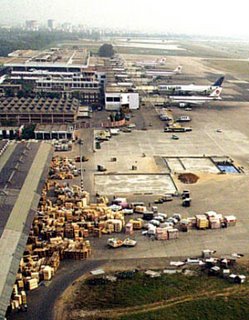
Cargo section aerial view
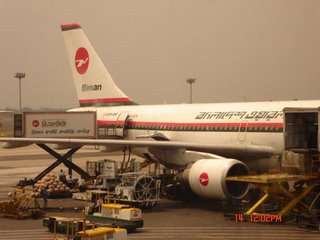
Biman Boarding

Exit lobby
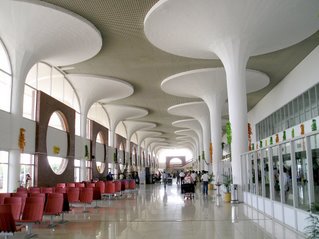

Entry lounge

Check-in area


Waiting lounge

Immigration counter for foreigners
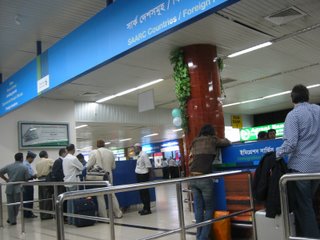
Immigration counter-SAARC countries


Farewell kiss from grandpa to Rashdan- 14 feb 2006
In 1941, during the World War II, for operating warplanes towards the war fields of Kohima (Assam) and Burmese war theatres, the British government of India had built military air base- airstrips at Tejgaon, north of Dhaka at a place called 'Dainodda'. Another landing strip further north of it at Kurmitola (Balurghat) was also made. Both these airstrips had military fighter plane landing facilities and safe up-keeping for aircraft, the strips were operative in 1943. Several dozens of fighter planes were stationed at these strips which were visible from the passing trains on Dhaka-Tongi line.
After independence, it took several years for the country to gear up works left over by the previous contractors and consultant due to war. The central portion of the present terminal bldg with the runway was formally opened during 1980-81 by President Zia. After the death of Zia, the airport was named after him in 1983.
After 1992, the airport terminal area saw rapid expansion in phases with addition of boarding bridges and equipments. A multi-storey car park with 500 cars was also built. With a total area of 1300 acres, ZIA International Airport is nation’s biggest. More than 16 international airlines use this airport. The airport handles half a million passengers and 98,000 million tons cargo annually. Aviation infrastructure is developed and maintained by the Civil Aviation Authority of Bangladesh (CAAB). It is the home base and hub of state-run Biman Bangladesh Airlines and private company GMG Airlines Bangladesh. Zia International Airport’s terminal building is equipped with most modern facilities and has an impressive architecture.
(Update: In 2010 Zia Airport has been renamed as Hazrat ShahJalal Int. Airport)
Apart from the British air force, Ispahani groups (Calcutta based) established in 1946 operated civil air-carriers (DC-3 Dakota) in Tejgaon strip in the name of 'Orient Airlines'. After partition of India in 1947, Tejgaon became the first civil airport in East Pakistan (now Bangladesh) and Orient Airlines operated Dakota propeller planes. Flights were operated between two wings of Pakistan via Delhi, Dhaka-Kolkata and Dhaka-Yangoon route etc. In 1948, Govt established East Pakistan Flying Club with couple of 'Tiger Moths' to train local youths in the field of piloting. These planes made spectacular aerial display over Dhaka sky every year during celebration of national day. To evoke peoples enthusiasm, a free air ride over Dhaka sky was arranged. Several dozen lucky numbers were chosen at Tejgaon airport on the flight date in presence of thousands of participants registered with the air force recruiting centre at Bakshi Bazar for the free ride in air force transport plane.
Govt took over the civil aviation and made it public sector activity in early 1950's. Pakistan Int. Airlines (PIA) was formed and it became the national carrier of Pakistan. Orient Airlines was taken over by them in 1955. Tejgaon airstrip was widened and runway extended for use of heavier planes (Super-Con and Boeing). The terminal building renovated. PIA flew its first Super-Con plane on the 7 June 1954 linking Karachi and Dhaka, which were the main cities of the main cities of the country's western and eastern halves. Kurmitola airstrip remained with Pakistan Air force.
In 1965, PIA domestic routes in East Pakistan operated helicopter services with Sikorsky helicopter. To cope with the increased air-traffic Tejgaon terminal failed to fulfill its requirement as a international airport. In mid 60's the area north of Kurmitola was selected and tender floated for construction of terminal bldg. and runway under technical support of French experts. For transportation of constn. materials a rail station (present airport rly stn) was established near the site. The new airstrip was halfway done when the war of liberation broke out in 1971 and the airstrip suffered severe damage .
Govt took over the civil aviation and made it public sector activity in early 1950's. Pakistan Int. Airlines (PIA) was formed and it became the national carrier of Pakistan. Orient Airlines was taken over by them in 1955. Tejgaon airstrip was widened and runway extended for use of heavier planes (Super-Con and Boeing). The terminal building renovated. PIA flew its first Super-Con plane on the 7 June 1954 linking Karachi and Dhaka, which were the main cities of the main cities of the country's western and eastern halves. Kurmitola airstrip remained with Pakistan Air force.
In 1965, PIA domestic routes in East Pakistan operated helicopter services with Sikorsky helicopter. To cope with the increased air-traffic Tejgaon terminal failed to fulfill its requirement as a international airport. In mid 60's the area north of Kurmitola was selected and tender floated for construction of terminal bldg. and runway under technical support of French experts. For transportation of constn. materials a rail station (present airport rly stn) was established near the site. The new airstrip was halfway done when the war of liberation broke out in 1971 and the airstrip suffered severe damage .
After independence, it took several years for the country to gear up works left over by the previous contractors and consultant due to war. The central portion of the present terminal bldg with the runway was formally opened during 1980-81 by President Zia. After the death of Zia, the airport was named after him in 1983.
After 1992, the airport terminal area saw rapid expansion in phases with addition of boarding bridges and equipments. A multi-storey car park with 500 cars was also built. With a total area of 1300 acres, ZIA International Airport is nation’s biggest. More than 16 international airlines use this airport. The airport handles half a million passengers and 98,000 million tons cargo annually. Aviation infrastructure is developed and maintained by the Civil Aviation Authority of Bangladesh (CAAB). It is the home base and hub of state-run Biman Bangladesh Airlines and private company GMG Airlines Bangladesh. Zia International Airport’s terminal building is equipped with most modern facilities and has an impressive architecture.
(Update: In 2010 Zia Airport has been renamed as Hazrat ShahJalal Int. Airport)
An excellent initiative! Photos always speak better than texts. I just saw the photos, and realize perfectly how the airport developed gradually. Thanks for the initiative.
ReplyDeleteIt is a wonderfull initiative thats every one will be able to know more about history of the air port
ReplyDeleteThanks
Thanks for sharing this useful information. Can you also share the other facility available such as: wifi internet, continental restaurants, etc. Thanks again.
ReplyDeleteThanks for generating these rare pictures. Very educational.
ReplyDeleteIts interesting to see photos of the airport, which could probably never capture the fact that coming back from any country you get the feeling that we're making whatever progress we are very slowly, whereas most neighboring countries are advancing in far bigger steps. We don't get the sense of how messy Biman's service is, or how you see people with guns all over the drop off area, or the inefficient immigration officers. Pictures are worth a thousand words? Sometimes, in a wrong way.
ReplyDeleteunbelievable collection of picture!!! its imagine, all the history of Airport in a one place!!!
ReplyDeleteThanks for Sharing. Its a History. Love it.
its a Magic!!! unbelievable picture in a Blog!! All picture are a history. I did not seen this pic, this is first. thanks is very little for this jobs. i don't know how can i appreciate. Its great jobs.
ReplyDeleteYour are really great.
ReplyDeleteThanks a lot.
ReplyDeleteExcellent. Good to see history coming alive with the good old photo.
ReplyDelete